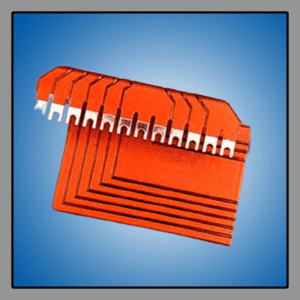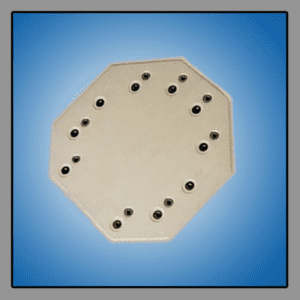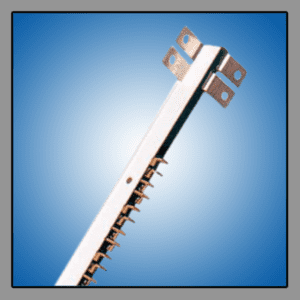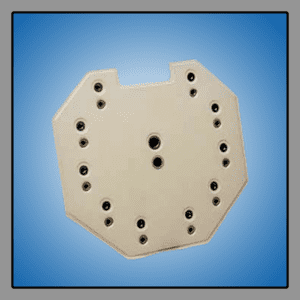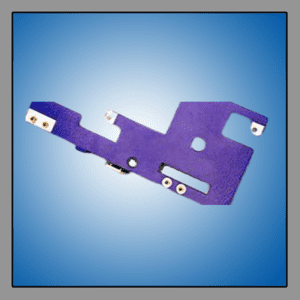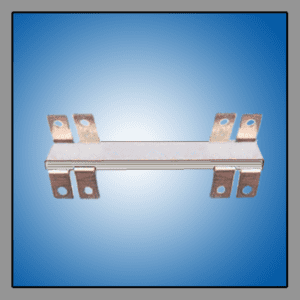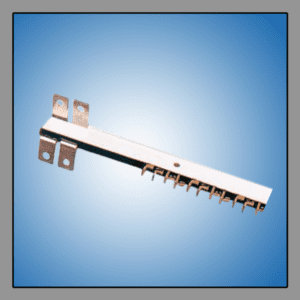ABOUT LAMINATED BUS BAR STRUCTURES
The two power distribution technologies used in modern electronic equipment are wiring harnesses and bus bars. Typically, a bus bar would be used instead of a wiring harness when significant current is required.
Wiring harnesses are cost-effective in low-volume, low-current applications and provide adequate performance, except in applications where high capacitance, low impedance, electrical predictability, and dense packaging are required. Bus bars began to replace conventional wiring harnesses in the early 1960s. Recently, with advances in power semiconductor capability to operate at higher switching frequencies and currents, laminated bus bar structures have become much more prevalent.
Much more than just a rectangular conductor, the modern laminated bus bar structure is a precision electrically and mechanically-engineered passive circuit component, consisting of layers of tightly coupled conducting plates fabricated copper or alumi
num, separated by thin dielectric materials laminated into an integrated structure.
There is a multitude of challenges caused by increasing logic and memory circuit switching rates, shrinking space availability, and demanding noise, thermal, and reliability constraints. To help meet these challenges, packaging designers have increased their use of bus structures in their designs. These bus bar structures are the standard method for transferring power in telecommunications, electronic power conversion, motor drives, AC, DC, or high-frequency power distribution, and other related electronic applications. Multilayer bus bars reduce system costs, improve reliability, and eliminate wiring errors. They provide structural integrity that cannot be offered by traditional wiring harnesses.
WHY USE LAMINATED BUS BAR STRUCTURES?
The primary purpose of this laminated bus bar structure is to make connections between two or more points or circuits, whereas a conventional bus bar uses only a single layer metal conductor. Laminated bus bar assemblies also control critical electrical parameters.
Properly designed laminated bus bar structures help to control inductance, capacitance, and impedance in a bus bar assembly. There are two components of a conductor inductance which are; self-inductance and mutual inductance.
WHY IS INDUCTANCE A CONCERN?
When using IGBT's, low inductance is a critical element for safe and efficient operation. Stray inductance on the source-return path of the DC bus bar from the DC capacitor bank to the inverter devices can cause:- Reduced switching frequency - Parasitic oscillations may get out of control and cause the inverter to exceed its safe operating area.
- Excessive transient overshoots - In conventional hard-switching converters, this results in increased device heating, which eventually exceeds the device's safe operating area causing device failure.
SELF-INDUCTANCE
In comparing a round conductor to a rectangular bus bar typically used in laminated bus structures, the rectangular bus bar has 1/3 to 1/2 the self-inductance of a round conductor of equal length and cross-sectional area.MUTUAL INDUCTANCE
With a laminated structure, mutual inductance reduction occurs with bus bars configured in a side-by-side layout. This has less effective inductance than wiring harnesses because of their shape and the existence of some mutual cancellation along the conductor edges. Appropriate geometries and paths of the conducting points are designed to allow current in a multi-layered structure to flow in opposite directions and equivalent strengths, such that opposing voltages are generated in proportion to the rate of current change in a circuit. This causes any magnetic fields to be greatly reduced. The lowest effective inductance occurs when a wide DC plus plate is placed directly on top of a wide DC minus plate. This provides a greater surface area for flux cancellation since conductors with opposite current polarity are in close proximity to each other. The closer the conductors can be placed to each other, the greater the mutual cancellation and decrease in effective inductance.LAMINATED BUS BAR CONSTRUCTION
Our laminated bus structures consist of several layers of electrically conductive metal (usually copper), separated by insulating materials, such as; Kapton® (Polyimide) for high-temperature applications, and Mylar® (PET) / Tedlar® (PVF) for lower temperature applications.
When producing the following: laminated bus bar sealed edge (Planar bus), filled edge laminated bus bar (Laminar bus), or open edge laminated bus bar. All the conductors, insulation, and terminations are laminated under controlled heat and pressure. This creates a single laminated bus bar structure.
DIELECTRIC INSULATIONS
Below are dielectric insulations that can be used. One insulation material or several different materials can be combined in a design. The combination of materials is dependent on the electrical, mechanical, and environmental requirements.| Electrical Insulation Materials | Continuous Use Temp °C | Dielectric Constant ASTM D150 | Dielectric Strength (Volts/mil) ASTM D149 | Flammability Rating | Comments |
|---|---|---|---|---|---|
| Epoxy Powder Coating | 130 | 4 | 800 | UL 94 V-0 | Flame- and moisture-resistant, ideal for multiple shapes |
| FR-4 | 140 | 4.3 | 1250 | UL 94 V-O | Epoxy-fiberglass laminate providing superior mechanical and dimensional stability |
| Kapton® | 400 | 3.7 | 5000 | UL 94 VTM-0 | Polyimide film, exceptional heat resistance, superb mechanical and electrical properties |
| Mylar® (PET) | 105 | 3.3 | 7500 | UL 94 VTM-0 | Polyester Film that is strong, cost-effective, chemical, and moisture-resistant. |
| Nomex® | 220 | 1.6 | 430 to 845 | UL 94 V-0 | A Dupont aromatic polyamide which is durable, flame-resistant and has superb high voltage breakdown. |
| Tedlar® (PVF) | 105 | 11 | 3500 | UL 94 HB | Polyvinyl fluoride film that is strong flexible, has good resistance to chemicals and aggressive cleaning agents. |
| Tonex® (PEN) | 140 | 3.4 | 5000 | UL 94 VTM-0 | Superior properties such as deflective strength, heat resistance, anti-hydrolysis, dimensional stability and low oligomer extraction. |
| ULTEM® 1000 | 170 | 3.15 | 830 | UL 94 V-0 | Unfilled polyetherimide PEI, exceptionally high mechanical properties and ease of fabrication including bonding |
ADVANTAGES OF LAMINATED BUS BAR STRUCTURES VERSUS CONVENTIONAL WIRE HARNESSES
- Reduced systems costs
- Eliminate wiring errors
- Minimum voltage drops
- Lower impedance
- Higher capacitance
- Denser, more compact packaging
- Reduced RFI, EMI, cross talk
- Direct mating with power supply, motherboards, etc.
- Improved integration with other power components including: capacitors, fuses, circuit breakers and filters
- Improved reliability
- Easier installation
- Lower inductance
- Greater electronic noise filtering
- Wider choice of input/output methods
- Improved thermal characteristics
- Can be made of aluminum
- Rigid construction tolerates huge magnetic forces under "fault" conditions
- Thermal management – they radiate heat better than insulated cables
TYPES OF LAMINATED BUS STRUCTURES
LAMINAR BUS - FILLED EDGE LAMINATED BUS BAR
A laminar bus bar consists of multiple copper and insulation layers which are stacked and laminated creating channels between the conductive plates. These channels are now filled with epoxy, effectively potting the edges with insulation compound to completely enclose the conductors.
The lamination extends less than other construction methods allowing the overall footprint to be reduced. Multiple conductors utilize an epoxy edge filled or glass edge filled construction. Multiple terminations and multiple forms can be chosen. Laminar bus bars are excellent for high current capacity and structural stiffness. Filled edge laminated bus bars provide a strong and durable barrier to moisture and other contamination.
PLANAR BUS – LAMINATED BUS BAR SEALED EDGE
The planar bus bar uses multiple conductors laid side by side, with the lamination extending past the conductor. It is then close-molded providing 100% sealed edges. It is also called a pinched sealed laminated bus bar. A solitary planar bus bar conductor can be close-molded with insulation creating a single layer pinched sealed laminated bus bar.
Molded/pinched sealed laminated bus bar construction is a first-rate choice for multiple terminations allowing for numerous bends. For compact spaces and medium current capacity, a laminated bus bar sealed edge construction is ideal.
EPOXY BUS - EPOXY POWDER COATED LAMINATED BUS BAR
The basic epoxy bus bar uses just a single thick conductor. An electrostatic epoxy powder coating provides dielectric insulation. With epoxy powder coated laminated bus bars, multiple layers can be mechanically assembled by means of PSA tape.
Different powder coating colors can be used to distinguish different layers in an epoxy bus bar assembly. Additional hardware can be added to provide a complete value-added assembly. Epoxy powder coated laminated bus bar structures lower costs and maintain minimal creepage. The epoxy bus bar construction is well suited for high current and will tolerate high temperatures.
OPEN EDGE LAMINATED BUS BAR
Open edge laminated bus bar allows the lamination to extend past the conductor. This distance along the insulation provides dielectric creepage and clearance. However, with no additional fortification on the edges, environmental protection is limited to the surface coating/plating applied to the conductive bus.
With this type of construction, it is also important to note that the "creepage distance" may be significantly reduced. This will occur if the bus bar surfaces between two potentials have debris or moisture. Current can track along the surface of the insulation creating shorts circuits and hi-pot failures.
Because of this contamination risk, an open-edge design is best used in clean and dry environments.
IS YOUR PROJECT A GOOD APPLICATION FOR A LAMINATED BUS STRUCTURE?
To find out if your application can benefit from laminated bus bar technology, please e-mail us the following information and/or your drawings in STEP, STP, STL, IGES, SLDPRT, X_T, DWG or format:
